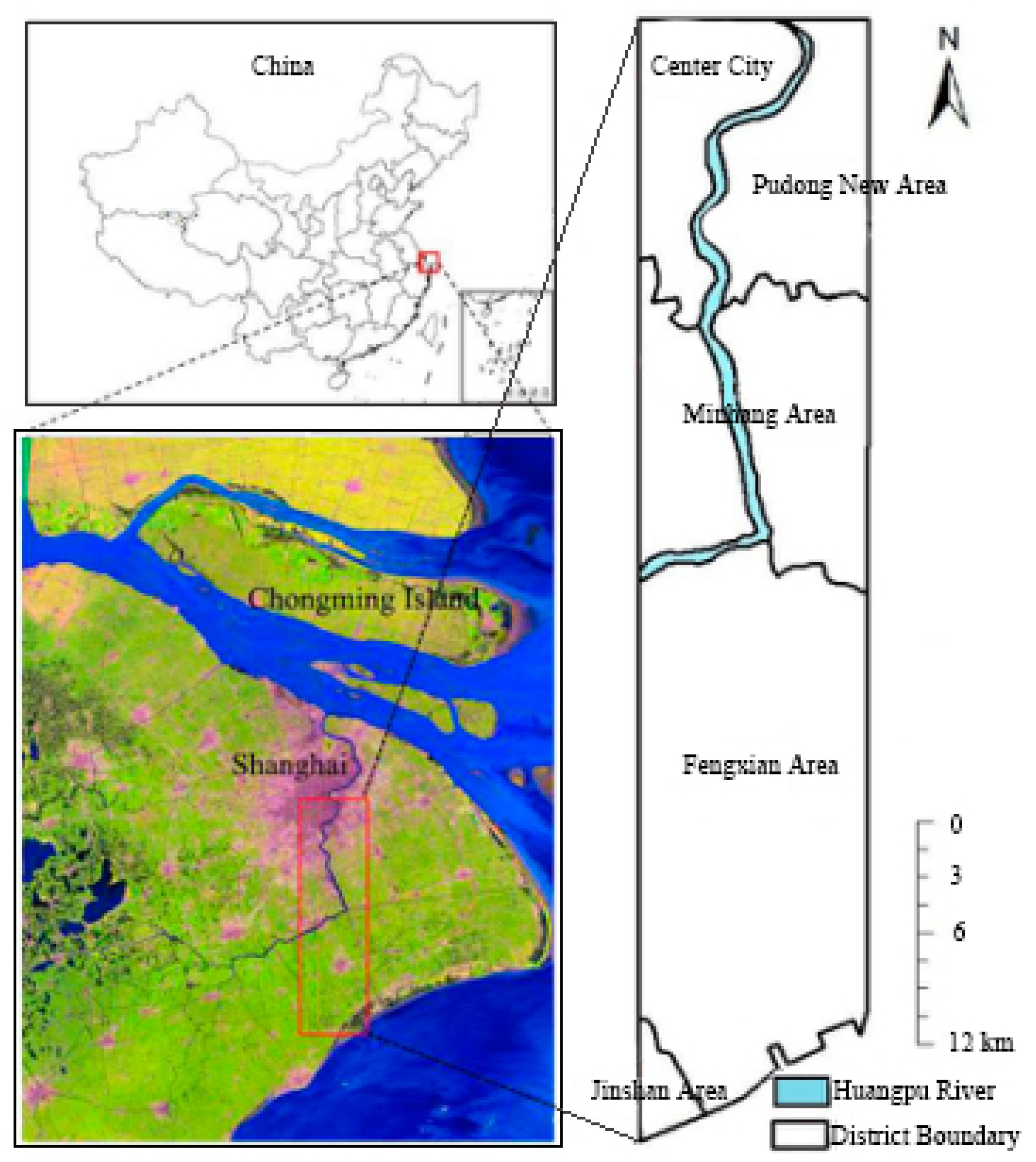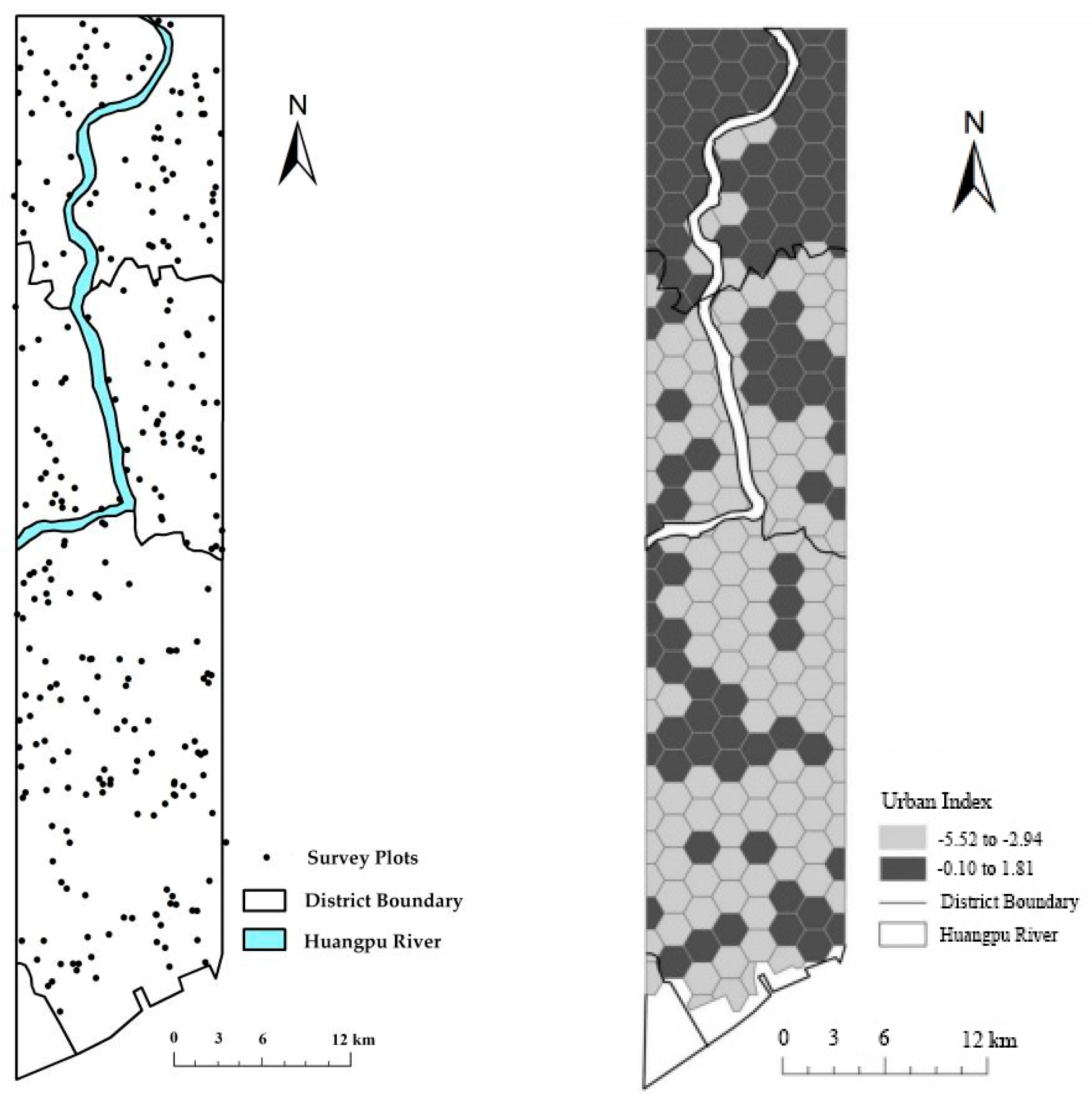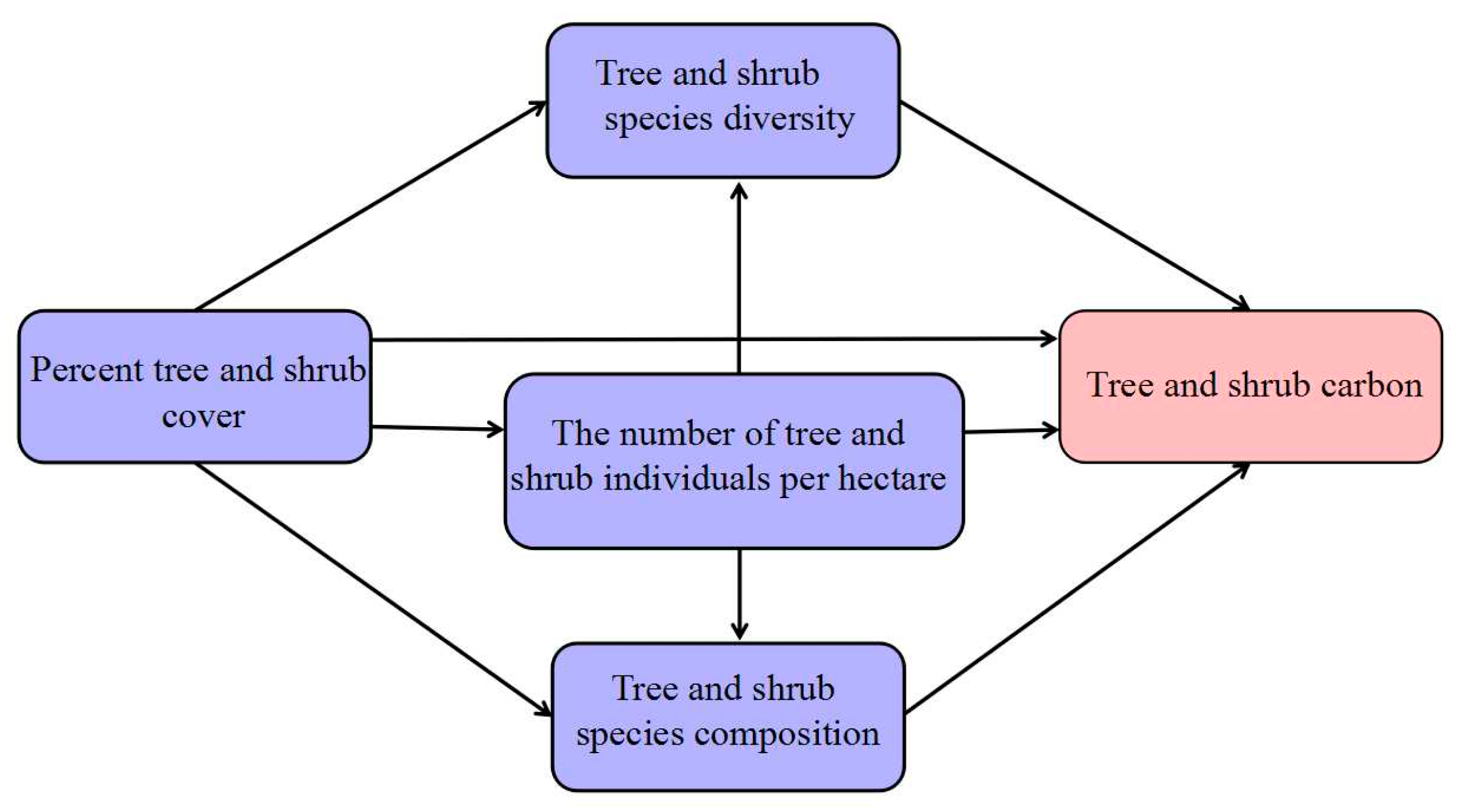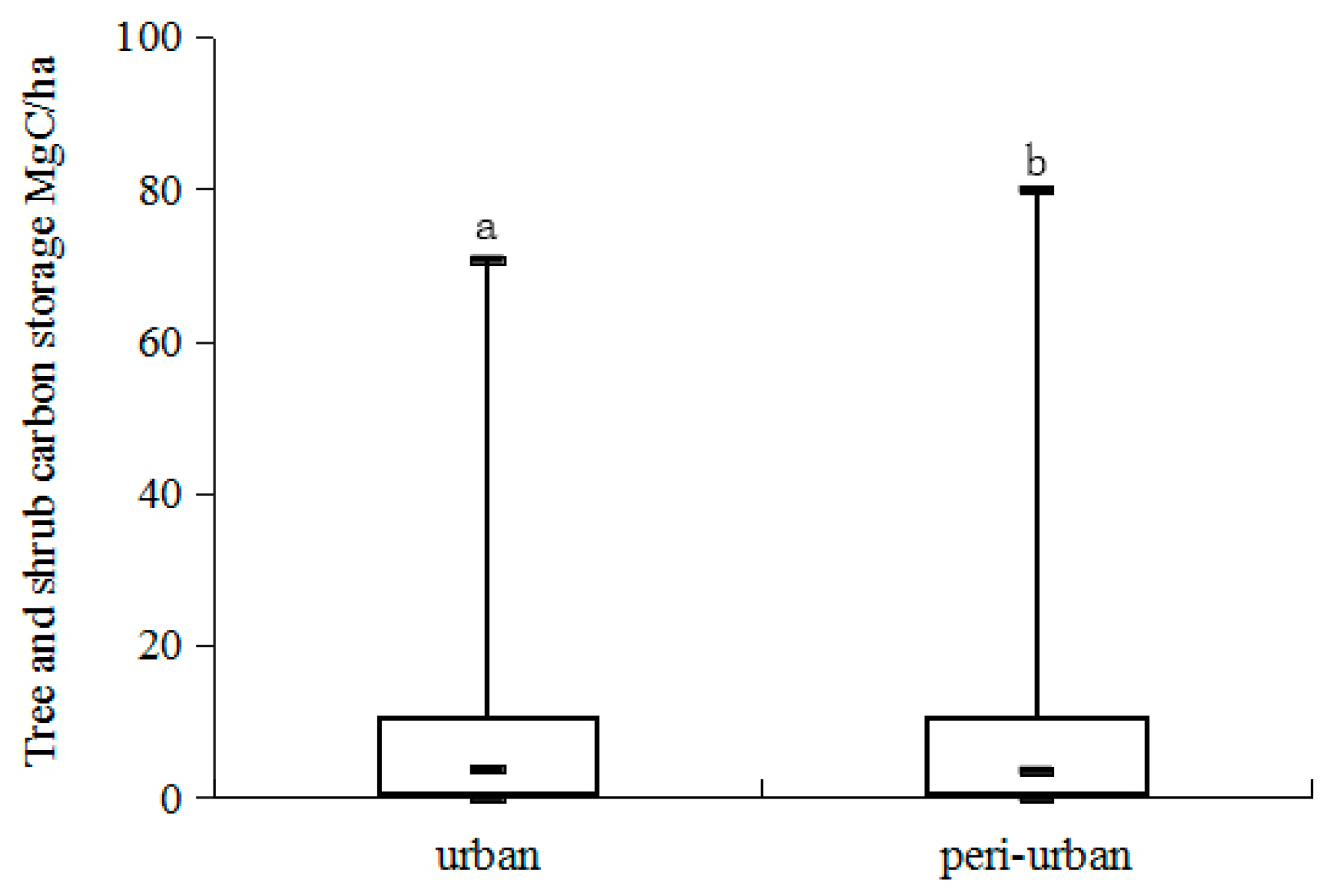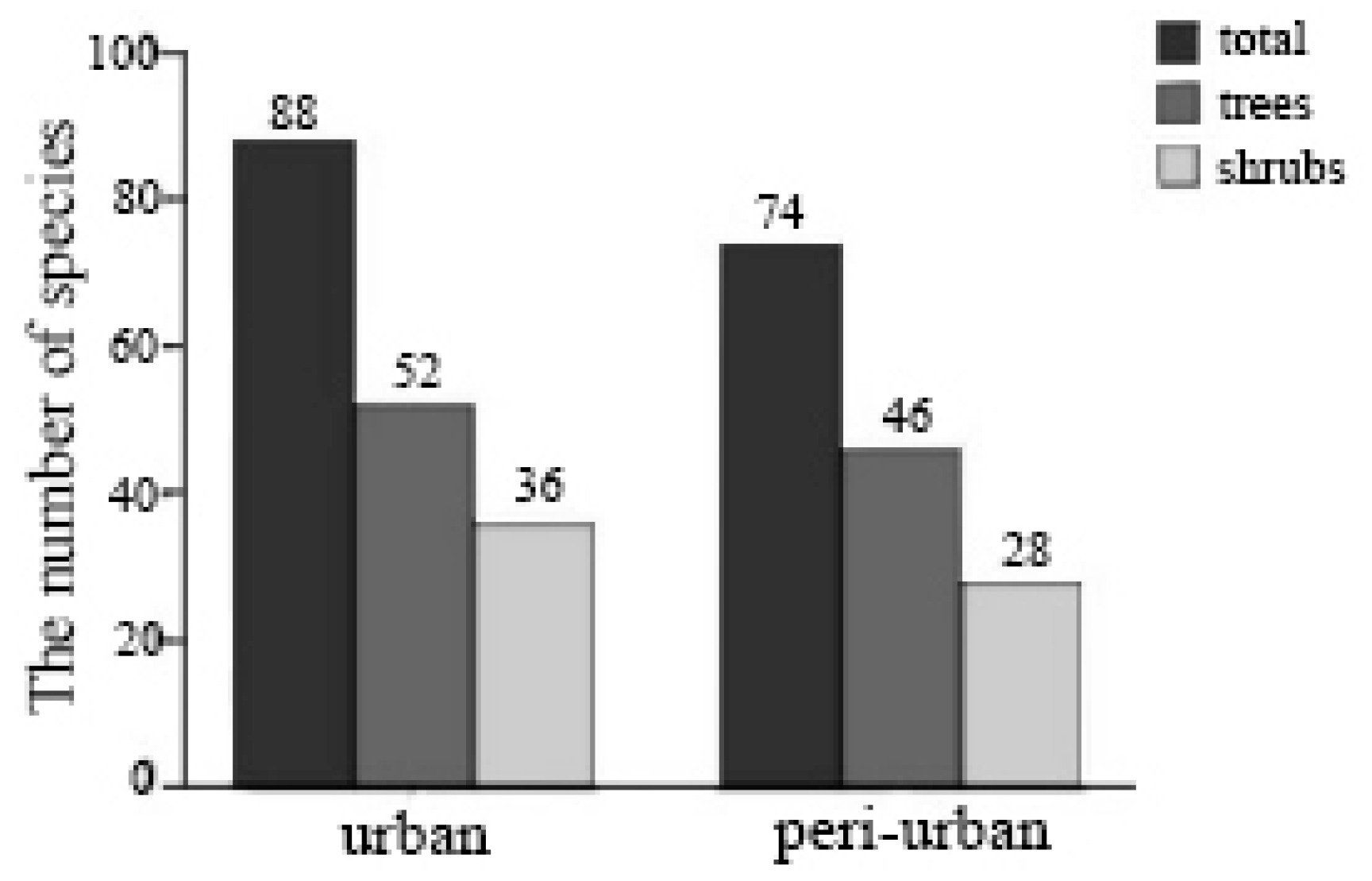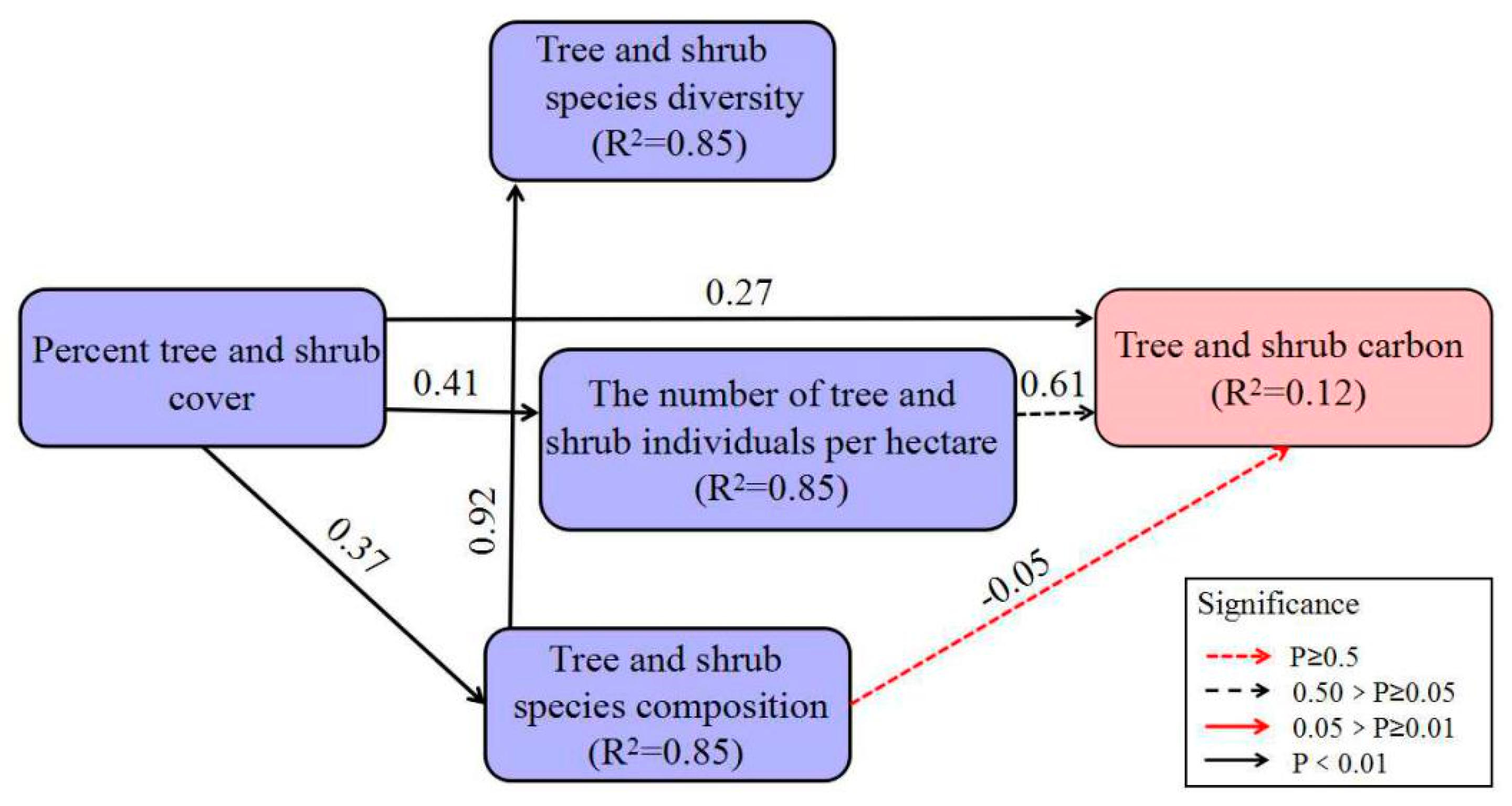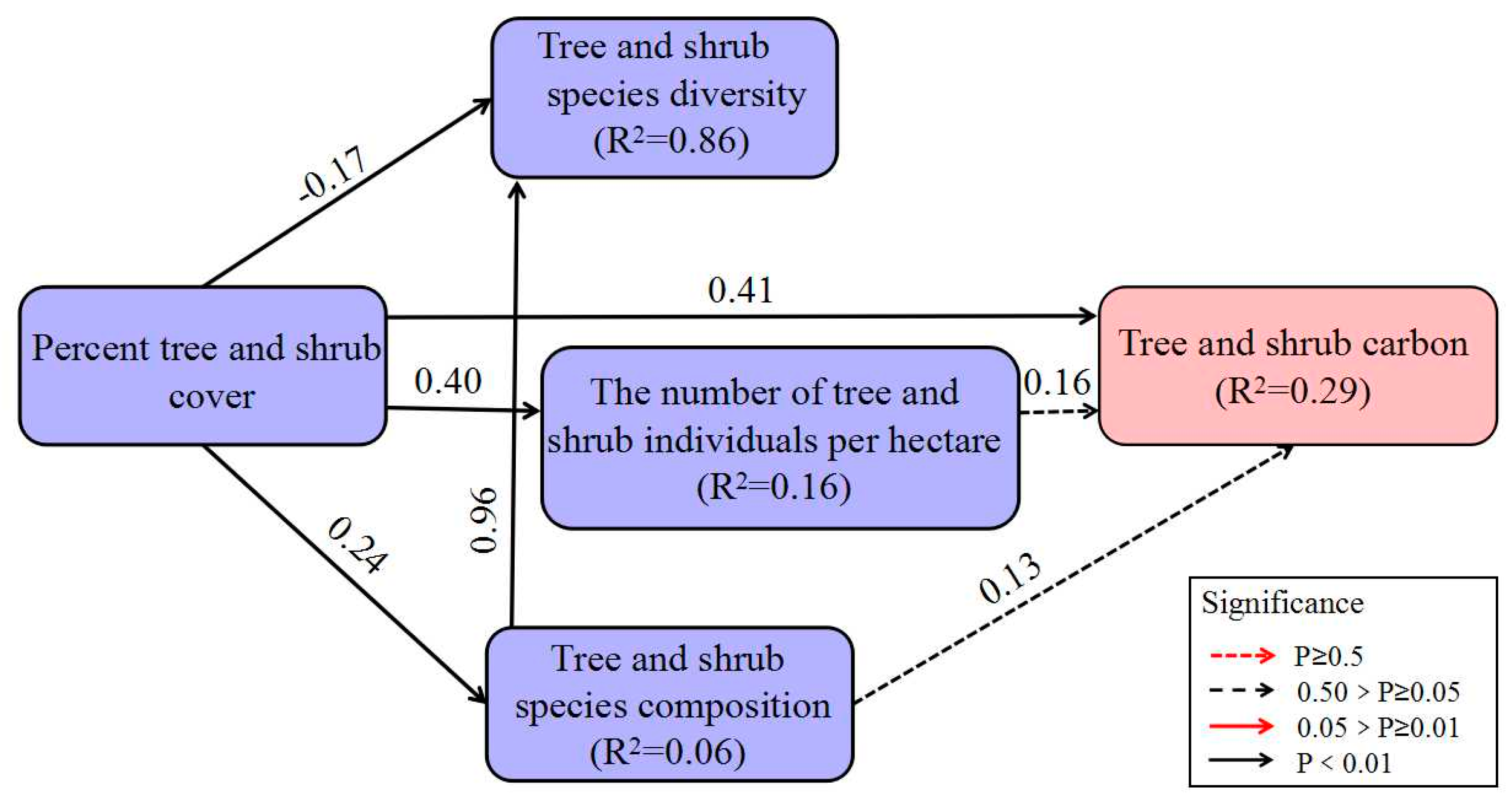1. Introduction
Urban forests are the sum of all trees, shrubs, and palms present in a city and are a key nature-based solution for mitigating climate change effects and providing other ecosystem services [
1,
2,
3]. Forests and plant communities in peri-urban contexts are also increasingly experiencing disturbance through urbanizations and alteration of their composition, soils, and biogeochemical cycles [
4,
5,
6,
7,
8,
9,
10]. Indeed, the structure, function and subsequent ecosystem services from urban forests are highly influenced by land use change and human decisions [
11,
12]. Urban forests and their ecosystem functions across the forested biomes of the world play an important role in the local urban and global carbon cycles; yet they can be directly and indirectly influenced by multiple factors including tree composition, urban forest structure, and related growth, mortality, and carbon emissions from decomposition and maintenance activities [
2,
3,
13,
14,
15,
16]. However, given the heterogeneity of urban forests, quantitative causal analyses or identification of key indicators and drivers influencing carbon storage in subtropical urban and rural or peri-urban forests have been little studied.
Previous urban forest ecosystem studies have documented a correlation between structure, composition, diversity and carbon storage, and similarly that tree cover and land use and land cover (LULC) are correlated to carbon storage [
2,
3,
4,
13,
17,
18]. Also, urban forest carbon storage is a key indicator when managing and planning for urban forests [
7,
19,
20]. However, given the growing urbanization effects on forests literature and studies assessing the carbon storage of urban forests internationally [
21,
22,
23] there is little information outside of developed and temperate Europe and North America regarding the quantitative relationships between tree carbon storage and urbanization [
9,
24]. Similarly, different levels of urbanization, urban morphologies LULC will also affect urban forest functions as seen in studies such as those of Dobbs et al. (2014) [
11]. Thus, information on such dynamics are needed in places such as China due to its rapid urbanization, on-going large-scale tree planting projects, and the need to promote and conserve urban forests [
6,
7].
Most methods and models for estimating urban tree carbon storage are based on forest-grown trees and are then applied to urban trees [
3,
10]. Although correction factors and ratios are used to adjust for these differences, the growing body of literature mentioned above demonstrates that important environmental factors, such as temperature, growing-season length, CO
2 concentration, and other biotic factors can differ substantially across urban to peri-urban gradients [
25]. Thus, more than just correlating factors, identifying the direct and indirect causal factors driving carbon storage in both urban and peri-urban forests is also important for developing defendable management indicators, modeling variables, and predicting future changes in ecosystem function and services. Factors such as species composition [
26], in particular urban tree types [
13], and surface covers of the urban forest, have been documented as influencing carbon storage and will differ within cities [
15].
However, understanding such causal relationships is complex, as the effects of socio-economic and ecological drivers on urban forest function are driven by interactions between direct and indirect biotic and abiotic factors [
11,
27,
28]. Accordingly, Timilsina et al. (2014a) used path analysis (PA) to better quantify such direct and indirect causes on urban forest carbon storage in subtropical San Juan, Puerto Rico. Methods such as structural equation modeling (SEM) or PA are regularly used for causal analyses in ecological studies and can model the effects of both direct and indirect influences [
29]. Another method used to investigate the effect of urbanization on ecological patterns and processes is the urban–rural gradient approach [
30]. Urban gradient studies have utilized several sampling methods to represent urban intensity gradients and to differentiate urban from non-urban areas [
9,
31].
Yet, we know of few studies that quantitatively analyze causal factors, as opposed to correlations, of carbon storage in urban and peri-urban forests using more progressive quantitative techniques; for instance, PA and urban-rural gradients. In order to address this dearth of information, our objective was to analyze the differences in aboveground carbon storage between urban and peri-urban forests and quantify the influence of specific drivers such as percent tree and shrub cover, tree and shrub species diversity, number of tree and shrub individuals per hectare (i.e., density), and tree and shrub species composition. In the below study, a PA approach was used to develop a causal model based on the urban forest ecosystem literature and data at the plot-level across an urban to peri-urban gradient in Shanghai, China. Specifically, we hypothesize that first, percent tree and shrub cover will affect tree and shrub carbon storage directly and indirectly via their effect on tree and shrub species diversity, tree and shrubs density and tree and shrub species composition. Secondly, tree and shrubs density will influence carbon storage directly and indirectly via its influence on tree and shrub species composition and diversity. Finally, we hypothesize that tree and shrub carbon storage is directly affected by tree and shrub species composition and diversity.
A better understanding of the socioeconomic and ecological (i.e., socio-ecological) drivers behind carbon storage in urban ecosystems will provide land managers with necessary information on how to design more effective management objectives and policies that incorporate forests as an urban nature-based solution. This information is key in rapidly urbanizing areas of the subtropics and developing world. Additionally, such an approach can be used to explore the role of socio-ecological drivers on urban ecosystem function and services without the need for digital land use and land cover polygon data; information often not easily accessible in many contexts in low and middle income countries.
4. Discussion
As reported by Timilsina et al. [
15,
58], urban forest studies regularly use urban tree cover as a metric or correlate for ecosystem structure, function and services [
61]. Similarly, studies of urban forest carbon storage and sequestration have typically used plot data at the landscape level, that are stratified using GIS according to multi resolution LULC type polygons [
2,
6,
18,
21,
40]. Overall, we found that the tree and shrub carbon storage in Shanghai’s peri-urban forests (9.81 MgC/ha) was greater than in urban areas (8.92 MgC/ha;
Figure 4). Our results will differ from other studies, however. For example, in nearby subtropical Hangzhou China, C storage was 30.3 MgC/ha [
18]. Also, Horn et al. [
24] and Timilsina et al. [
15] report an average of 17.8 and 63.0 MgC/ha for urban forests in subtropical Orlando and Gainesville US, respectively.
Since the aim of this study was to analyze the drivers of above-ground tree-shrub carbon storage in urban and peri-urban forests in a subtropical context, it is difficult to compare our results with those of other studies. For example, Nowak et al. [
61] report whole tree (i.e., above and below ground) C storage for mostly temperate urban areas in the US in g/m
2 of tree cover as does Lv et al. [
6] for urban forests in northeast China. Additionally, different international studies will use different biomass equations, root-to-shoot ratios, remote sensing images with varying spatial resolution, and vegetation components (trees and/or shrubs and/or herbaceous) in reporting their estimates for different biomes, thus making comparisons difficult [
13,
18,
21].
Overall, tree and shrub cover in Shanghai had a significant, positive effect on tree and shrub carbon storage but also on tree and shrub species composition, tree and shrub species diversity, and the number of tree and shrub individuals per hectare (
Table 2 and
Table 4). We do note that tree and shrub cover had both direct and indirect effects on urban forest carbon storage, with indirect effects via the number of tree and shrub individuals per hectare being more influential than percent tree and shrub cover alone. However, there were differences in the effects of the same path, or in the relative influence of drivers of carbon storage between urban and peri-urban forests. Thus, increasing tree and shrub cover, particularly in peri-urban forests, can be an influential measure of increasing forest carbon storage.
Timilsina et al. [
58] also found that the relationship between urban tree cover and carbon storage was not direct. Dense, understory vegetation, invasive tall shrubs, and monocots (e.g., palms) with low biomass can also result in over estimates of tree cover in aerial images of the same area [
13]. Zhang et al. [
24] did show that individual tree carbon storage increased with decreasing tree density, shrub carbon storage increased with increasing tree and shrub species density, and carbon storage in all forest carbon pools (including standing vegetation, litter, and soil carbon) increased with decreasing tree and shrub density. Liu et al. [
62] showed that urban forest aboveground carbon storage and carbon sequestration increased according to tree and shrub density.
Our results show that tree-shrub diversity had not significantly affected carbon storage. Similar dynamics have been observed in San Juan, Puerto Rico [
58]. Tree and shrub species composition had a negative effect on tree and shrub carbon storage in urban forests (−0.05), but the effect was positive in peri-urban areas (0.13), that were not significant. This might be explained by the shorter ornamental tree and tall shrub composition that predominates in urban areas (
Table 2 and
Table 3)
. While larger, remnant or shade-providing trees predominate in peri-urban forests such as
Magnolia grandiflora Linn.,
Chimonanthus praecox (Linn.) Link, and
Cercis chinensis Bunge (
Table 2 and
Table 3)
.We hypothesized that percent tree and shrub cover, tree and shrub density, tree and shrub species diversity and composition might affect carbon storage directly and indirectly. Moreover, Nowak et al. [
17] in a study of carbon storage in US urban forests have also shown that two dominant factors affecting carbon storage density were tree and shrub density and diameter distribution. However, we did not analyze for the effects of tree diameter distribution and basal area in our path analysis model, two key, but little studied, correlates used in urban tree biomass estimates. The impact of some other biotic and abiotic driers of carbon storage were, however, not analyzed, including fertilization, soil quality, land use polices and ordinances, and other human management-maintenance activities. However, as stated earlier, national-level urban forest assessments do use tree cover as an index for estimating carbon storage [
58,
61] and other urban forest structural characteristics [
5]. Currently, Shanghai’s urban forest cover is lower than the national average [
39]. Thus, increasing peri-urban forest cover and density with specific trees and shrubs species can be a viable nature-based solution for mitigating CO
2 emissions from Shanghai.
In other parts of China, Lv et al. [
6] also found that tree C storage was greater, while soil organic carbon was the lowest in Harbin China’s temperate peri-urban forests. Ren et al. [
7] also documented that suburban areas in Xiamen City, China stored a greater portion of carbon than did urban forests in the city core. However, to our knowledge, other than Timilsina et al. [
58], there are no other studies that quantitatively analyze the different causal drivers behind tree carbon storage using PA or SEM or for that matter analyze the differences in aboveground tree-shrub carbon storage according to urban and peri-urban forest contexts.
5. Conclusions
Our integrated approach using field, plot and socio-ecological data to estimate tree and shrub carbon storage and to differentiate urban from non-urban sites using an urban–rural gradient and a local-scale hexagon-based urbanization index, instead of GIS land use cover polygons, can provide a potentially useful method for assessing other drivers of urban ecosystem service provision and demand across urbanization gradients. However, one limitation in our study is that we did not account for, or analyze, the causal role of ground vegetation covers (e.g., turf), soils, stand age, diameter distribution, and other biophysical drivers. Similarly including other socio-ecological drivers in our PA could have also elucidated other influences.
As such, future research can analyze the influence of other causal biotic and abiotic factors that drive carbon storage such as soil quality, fertilization, land use policies, human preferences and other management activities. In general, lower-density forests have a high potential for carbon sequestration. Hence, according to different stages of succession, the vegetation density is a key management objective that can be used to optimize community structure, improve habitat conditions, promote growth, and improve the carbon storage of the whole urban forest.
Our study presents a quantitative approach that can be used to better understand the site-specific carbon dynamics of urban forest and other ecosystem services and disservices. The use of plot-level data and a hexagon-based urbanization index instead of LULC data with varying sized polygons, provides a means of quantitatively understanding drivers of urban ecosystem services without relying on remotely sensed data from disparate scales and resolution. Our findings do show that understanding the influence of structural drivers such as percent tree and shrub cover on functions like carbon storage can be complex. Our study’s approach and findings do however contribute towards a better understanding of the complexities behind these processes and for giving land managers better information to design management objectives and policies that incorporate forests as an urban nature-based solution.
